Yi Peng: the Sky Lantern Festival
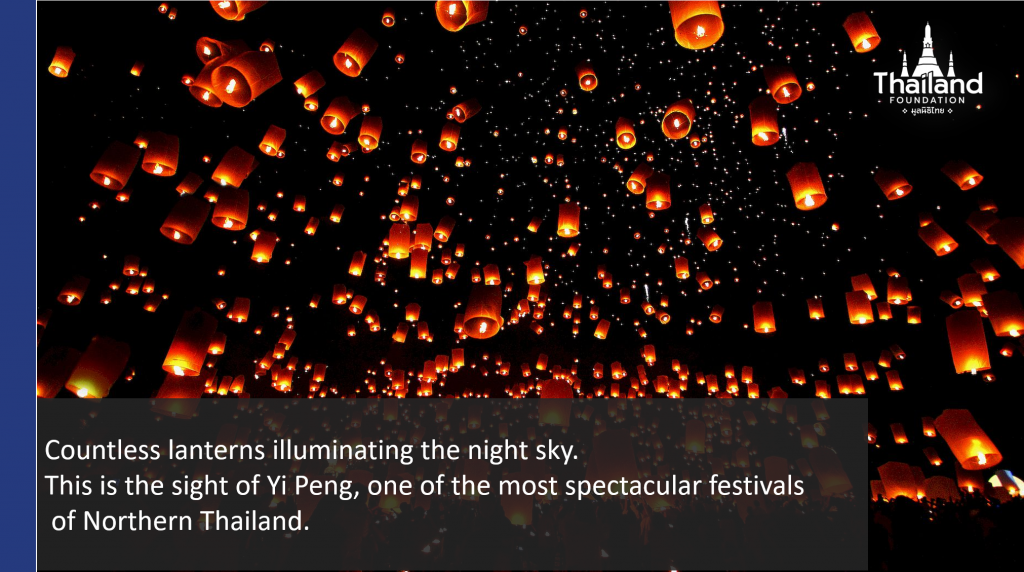
Northern Thailand’s Sky Lantern Festival, or Yi Peng, is perhaps one of the most charming and symbolic events of Chiang Mai province. Not only is this festival enchanting, but it is loaded with religious and cultural significance. It is a great way for foreign tourists to learn more about Thailand’s rich culture and traditions.
What is Yi Peng?
Yi Peng (ยี่เป็ง), sometimes written as “Yee Peng”, is a traditional festival that takes place in Northern Thailand. The name “Yi Peng” translates to “Full Moon of the Second Month”. The festival is also sometimes called the “Lantern Festival” or the “Festival of Light”. The highlight of Yi Peng is when participants launch paper lanterns called khom loy into the sky.
Yi Peng is a three-day event. The first day involves families preparing materials for merit making and festive activities. The second day involves the local community coming together at a temple to make offerings to monks and make donations to the poor. The third day involves a city-wide celebration during nighttime. This is where revelers are treated to the swarm of lanterns lighting up the night sky and phang prateep (earthenware lamps) decorating buildings. In rivers and ponds, they find small offering boats floating around, reflecting light on the serene waters. At its spiritual core, Yi Peng is the process of paying homage and showing respect to the Buddha. Traditionally, the exact date of the event is held in secret and is only announced shortly before the festival.
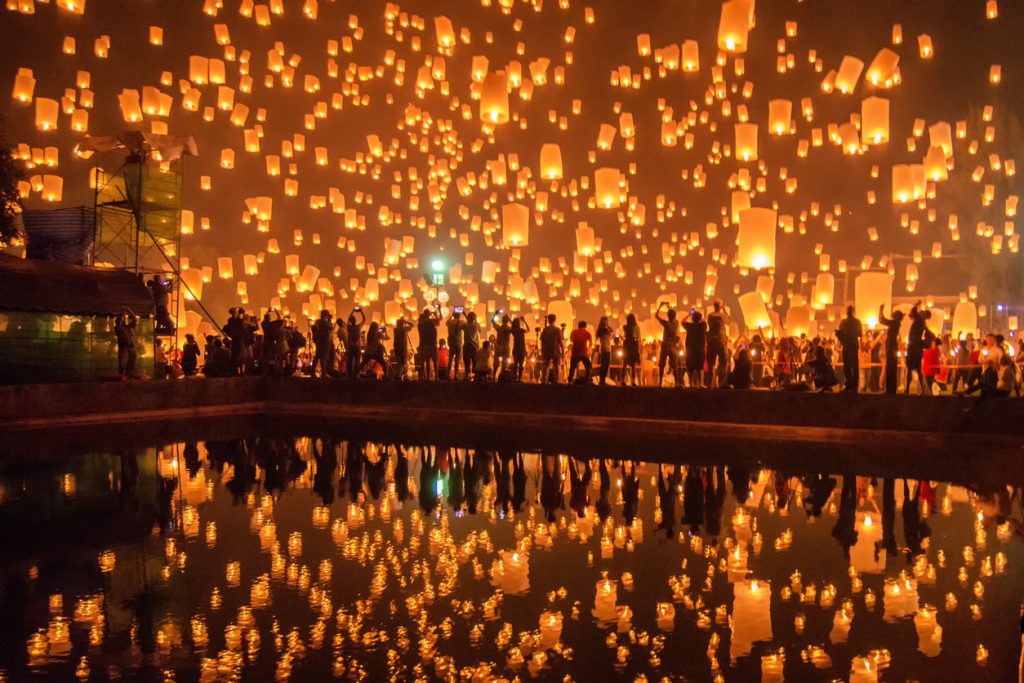
Origins
The origin of Yi Peng is connected to the spiritual beliefs and history of the Lanna (Northern Thai) people. With the Northern culture being deeply rooted in Buddhism, this festival can be seen as a way for the Lanna people to pay respect towards the Buddha’s relics enshrined in the legendary Phra That Kaew Chulamanee stupa on the full moon of the second month in the Lanna lunar calendar. The stupa is believed to be located at the highest of heavens. In order for their prayers to reach the heavens, the Lanna people used sky lanterns to send their prayers up to the sacred relics during the festival. It is also thought that releasing sky lanterns is equivalent to releasing bad luck and negative aspects of your life. This tradition is well known among Thais and foreigners alike, who are fascinated by its stunning and unique visuals.
Some people also believe that Yi Peng originated in India, with a legend stating that a group of birds once performed an act of reverence towards the Buddha by carrying torches in their mouths and talons and circling around him. The Buddha then stated that their actions has generated merit that will allow them to be reborn with beauty and popularity. Thus, in Northern Thailand, paying respect to the Buddha through votive light during Yi Peng is regarded as a way to be reborn into a life of popularity and purity.
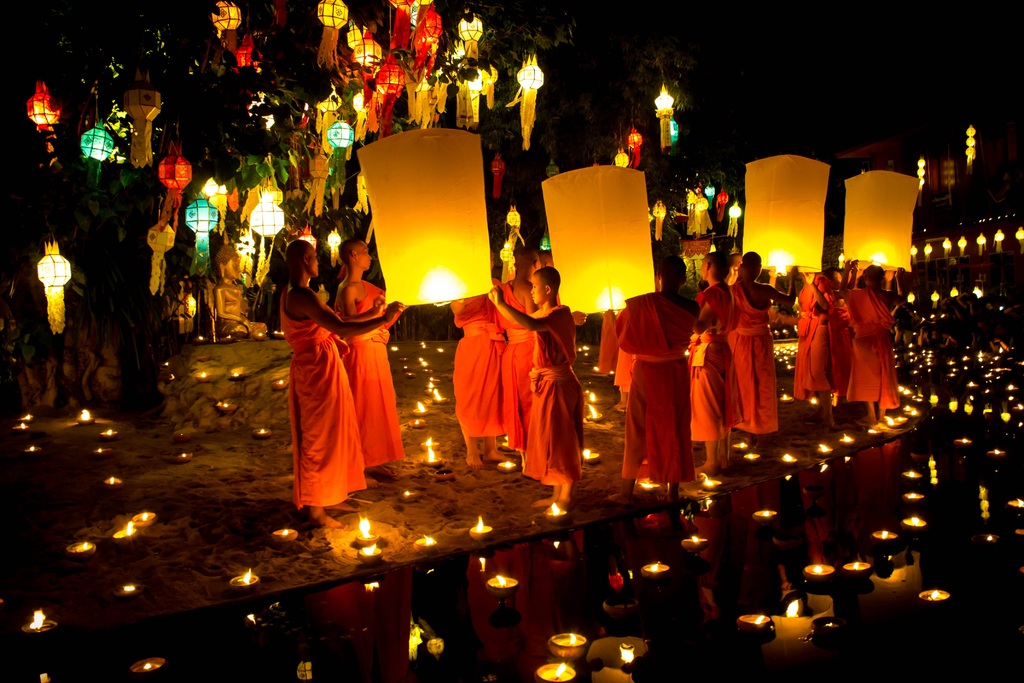
Another legend explains the practice of floating small boats and votive lights in bodies of water during Yi Peng. The legend harks back to the Haripunjaya Kingdom, an ancient state of the Mon people that used to flourish in Northern Thailand. During the 14th Buddhist century, an epidemic broke out in Haripunjaya, prompting people to evacuate to Hanthawaddy for about six years. During that time, many of them formed new families there. When they learned that the epidemic in Haripunjaya had subsided, those who longed for their homeland began their journey back. Upon reaching the anniversary of the year they left Hanthawaddy, they placed offerings such as incense and candles in small boats, and float them down rivers in remembrance of their relatives in Hanthawaddy.
Connection to Loy Krathong
Yi Peng is celebrated on the full moon of the second month of the Lanna lunar calendar, which usually falls in November. This coincides with the 12th month of the Central Thai lunar calendar. Yi Peng also coincides with another famous festival that is celebrated in other regions of the country, Loy Krathong Festival, and the two festivals are often fused together. The main event of both festivals happens after dark. Although most towns and cities across Northern Thailand celebrate Yi Peng, Chiang Mai is the most popular spot to experience this beautiful festival. The whole city is full of festivities, with bright shiny lanterns and candles lining the streets.
The Yi Peng tradition is based on the same beliefs as the Loy Krathong. The main objective is to worship the Buddha and other spiritual powers, such as ancestors and Phra Mae Khongkha (Ganga), the goddess of water. Traditionally, the Lanna people will use sapao (สะเปา) instead of krathong (กระทง). Sapao is a small handcrafted sailing ship, whereas krathong is a small float made from banana stalks. The villagers will make sapao together at the temple. In the evening of Yi Peng, they will place it on the bamboo raft along with various offerings and carry the sapao to the river. This tradition is also similar to the “Illuminated Boat Procession” which is practiced in North Eastern Thailand (Isan) and Laos. Nowadays, Northern Thais have adopted the use of krathong from Central Thailand. These two festivals attract lots of tourists every year to enjoy the celebrations of the city’s most incredible parades, firework display, launching sky lanterns, listening to Thai-Western fusion music and Traditional Lanna dance performances in public places.
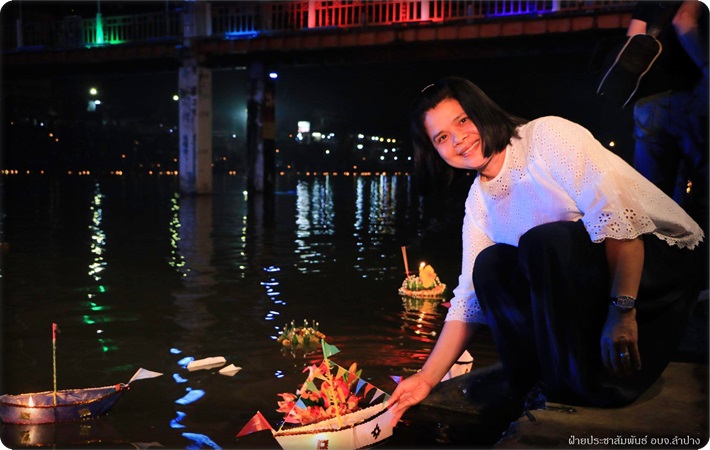
Floating sapao (cr. Lampang Provincial Administrative Organization)
The Lanterns
One of Yi Peng’s most iconic highlights is the display of paper lanterns. There are four types of lanterns used during the Yi Peng celebration: (1) khom kwaen (โคมแขวน – hanging lantern); (2) khom thuea (โคมถือ – carrying lantern), which can be divided into khom hoo gratai (โคมหูกระต่าย – resembling a rabbit’s ear) and khom kleeb bua (โคมกลีบบัว – resembling lotus petals); (3) khom phad (โคมผัด – revolving lantern); and (4) khom loy (โคมลอย – hot air floating lantern also known as khom fai – โคมไฟ). Khom loy are made of rice paper stretched over a bamboo frame with a candle attached at the base that are released and float up in the sky. The hot air from the candle is trapped inside the lantern and making it rise from the ground. The act of releasing the lantern symbolizes letting go of bad luck and misfortunes from the past year and wishing for good fortunes in the coming year. Many Northern Thai Buddhists believe that if you make a wish while releasing the lantern, it will come true. The lanterns are released at approximately the same time in the evening. The view of thousands of lanterns ascending into the night sky, with various levels of brightness and speeds, is truly mesmerizing. Because of this, the Yi Peng festival is often considered one of the most magical festivals in Thailand. Popular locations for lantern release in Chiang Mai province include the Ping River and historic temples, such as Wat Phan Tao and Wat Chedi Luang.
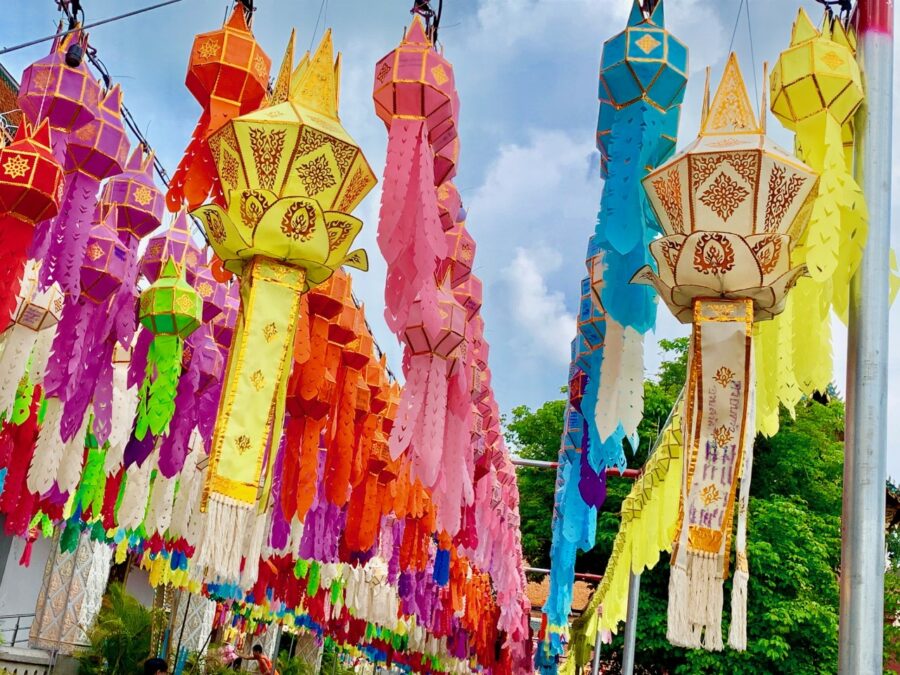
Assortment of khom khwaen (Suan Dok Variety)
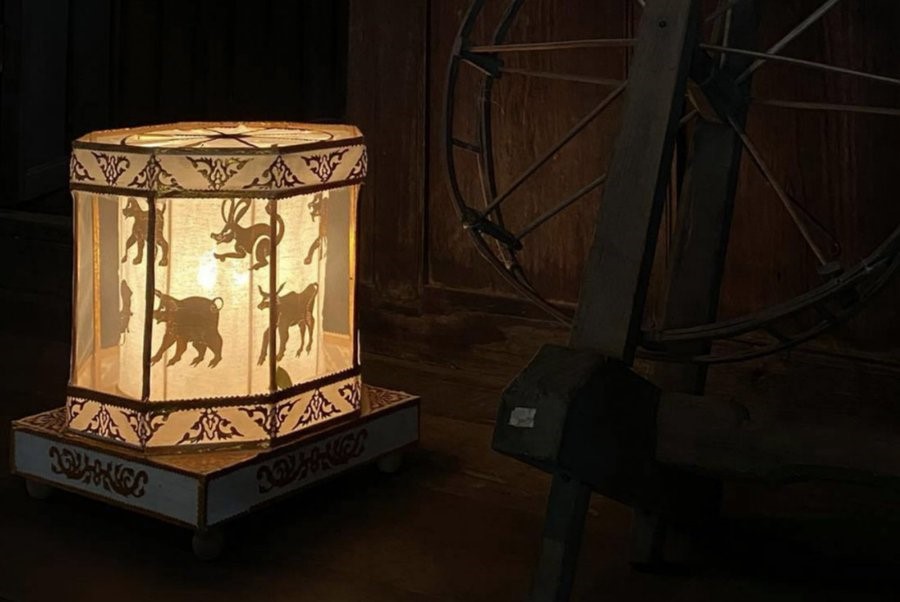
Khom phad (cr. X: @miscthailand)
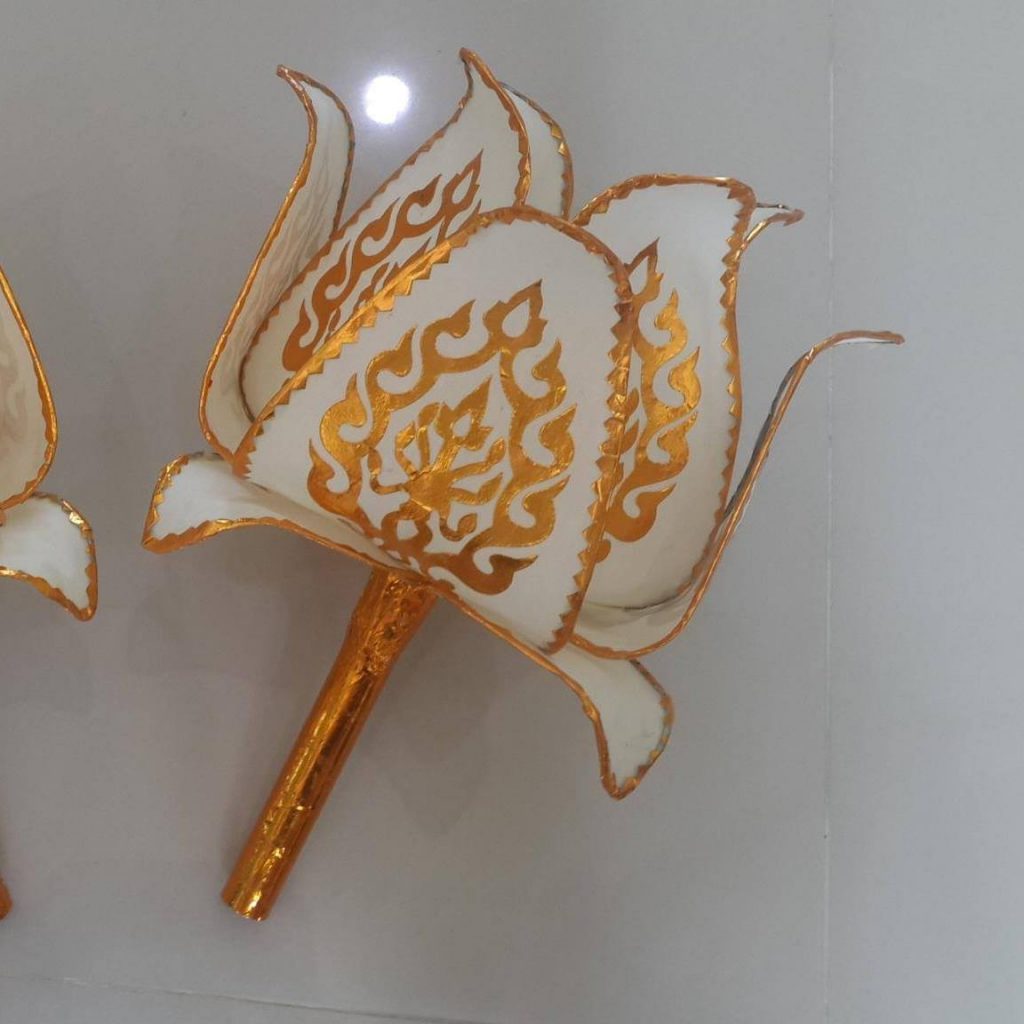
Khom kleeb Bua (cr. ณัฐชรัตน์โคมล้านนา)
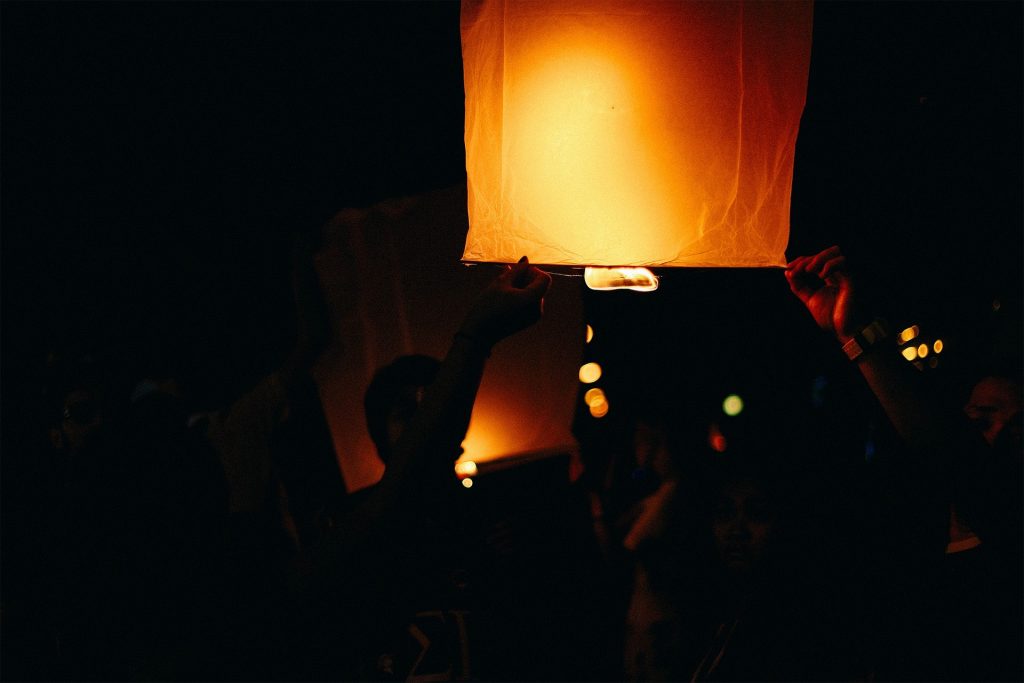
Khom loy (cr. The Library)
Phang Pratheep
Another aspect that is special about Yi Peng, and a particular highlight in Chiang Mai, is the heightened aspect of light to honor the Buddha. All around the city, the streets are illuminated with phang pratheep (ผางประทีป), small clay votive lanterns. The Lanna people believe that lighting of Phang Pratheep is an act of showing gratitude to all their benefactors. They are thankful for almost everything that benefits them such as the house and walls that protect them. The light of phang pratheep also symbolizes enlightenment and prosperity. During the festival period, you will notice phang pratheep light everywhere in Northern Thailand, from temples to local houses.
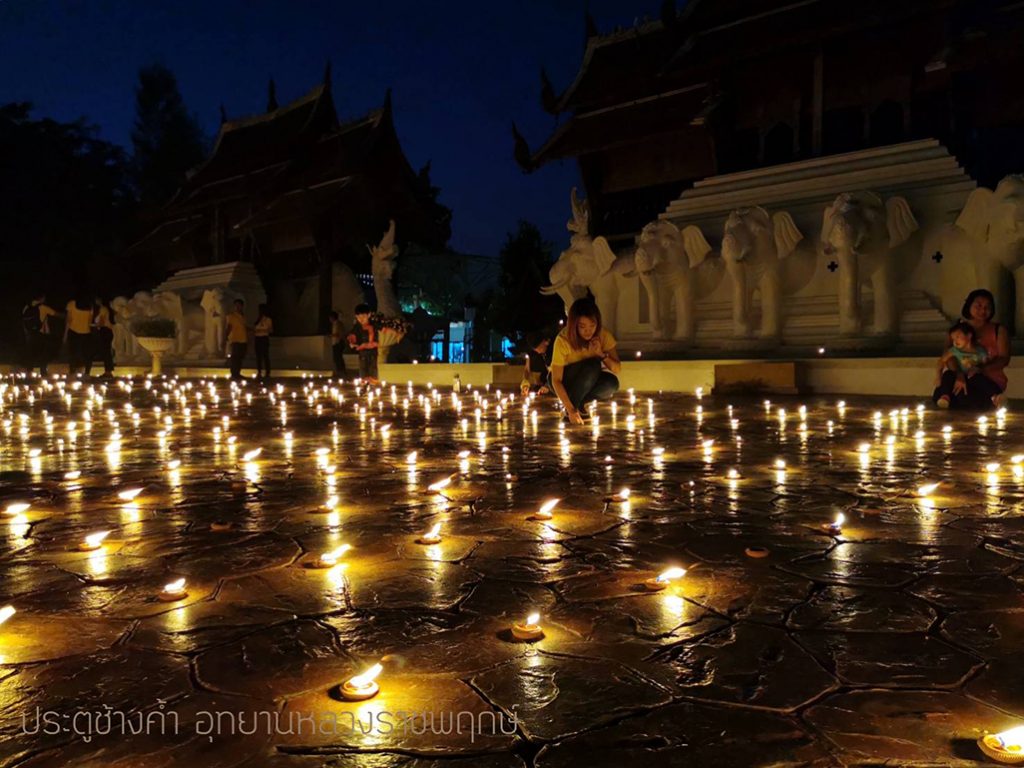
Lighting phang prateep (cr. Royal Park Rajapruek)
Conclusion
Today, the values of respect and compassion of the Northern Thai people still flourishes through their distinct customs and traditions. Yi Peng emerged as a prominent festival in this region, embodying religious reverence and community bonding. This festival is more than just a beautiful spectacle, it is a living testament to the history of the Lanna people and a continuation of a cultural legacy that thrives to this day. Yi Peng is a celebration deeply connected to spirituality and nature. The festival is an opportunity for cultural exchanges and is aligned with the essence and contribution to preserving Northern Thailand’s natural and cultural beauty. There is no better way to gain insight and appreciation for a culture than to observe and even participate in their traditions.
The story of “Yi Peng” represents a charming facet of Thai culture and heritage. The beauty of this festival can be felt twofold. There is the physical beauty from the display of lights. Then, there is also the intrinsic beauty from the acts of reverence and kindness of the Northern Thai people. If you ever have a chance, do not miss experiencing the Festival of Light with your own eyes. Join us in exploring more stories of Thailand and the Thai people, as we take you on a journey to discover Thainess.
Sources:
- Hickman, L. (2009). What’s the environmental impact of a sky lantern? https://www.theguardian.com/environment/ethicallivingblog/2009/jul/31/sky-lanterns [Accessed 27 Nov. 2017].
- Marshall, A. (2015). Gorgeous, Floating Lanterns Ground Flights in Thailand. http//www.citylab.com/transportation/2015/11/gorgeous-floating-lanterns-ground-flights-in-thailand/417210/27 Nov. 2017].
- Newton, P. (2014). Thailand lights up the night sky with a lantern festival. http://edition.cnn.com/travel/article/thailand-loi-krathong-festival/index.html 27 Nov.
- The Nation (2017). Airport adjusts flights for safety during the Yi Peng Lantern festival. The Nation.30 October http://www.nationmultimedia.com/detail/national/30330400[Accessed 27 Nov. 2017].
- Anand, S. (4 November 2017). Why Yee Peng Festival is Celebrated in ThailandRetrieved from: https://wandersnap.co/blog/history-yipeng-festival-celebrated-thailand/
- Ronald D. Renard, The Image of Chiang Mai: the making of a beautiful city, Journal of the Siam Society, 1999
Author: Vanthop Nilubol
Editor: Tayud Mongkolrat
24 November 2023


